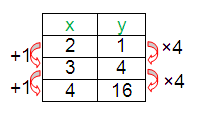DETERMINE IF THE ORDERED PAIR IS LINEAR EXPONENTIAL OR NEITHER
Subscribe to our ▶️ YouTube channel 🔴 for the latest videos, updates, and tips.
Linear function :
A linear function is a function whose graph is a line. Thus, it is of the form f(x) = mx + b where 'm' and 'b' are real numbers.
If the function is linear, then the difference between two immediate outputs will be equal.
Exponential function :
The function which is in the form y = abx
If the function is linear, then each output should be multiplied by the same constant throughout the outputs.
A function has the following coordinate points. Could the function represent a linear function, exponential function, or neither?
Problem 1 :
(1, 2), (2, 8), (3, 20)
Solution:

A constant change of +1 in x corresponds to different changes in y.
So, it is neither.
Problem 2 :
(10, 30), (11, 20), (12, 10)
Solution:

A constant change of +1 in x corresponds to a constant change of -10 in y.
Hence, the given set of ordered pairs represents linear function.
Problem 3 :
(13, 20), (14, 4), (15, 4/5)
Solution:

A constant change of +1 in x corresponds to an increase in y by a constant factor of 1/5.
Hence, the given set of ordered pairs represents exponential function.
Problem 4 :
(7, 6), (8, 12), (9, 20)
Solution:

A constant change of +1 in x corresponds to different changes in y.
So, it is neither.
Problem 5 :
(2, 1), (3, 4), (4, 16)
Solution:

A constant change of +1 in x corresponds to an increase in y by a constant factor of 4.
Hence, the given set of ordered pairs represents exponential function.
Problem 6 :
(5, 3), (6, 7), (7, 10)
Solution:

A constant change of +1 in x corresponds to different changes in y.
So, it is neither.
Problem 7 :
(3, -1), (5, 7), (7, 15)
Solution:

A constant change of +2 in x corresponds to a constant change of +8 in y.
Hence, the given set of ordered pairs represents linear function.
Subscribe to our ▶️ YouTube channel 🔴 for the latest videos, updates, and tips.
Recent Articles
-
Finding Range of Values Inequality Problems
May 21, 24 08:51 PM
Finding Range of Values Inequality Problems -
Solving Two Step Inequality Word Problems
May 21, 24 08:51 AM
Solving Two Step Inequality Word Problems -
Exponential Function Context and Data Modeling
May 20, 24 10:45 PM
Exponential Function Context and Data Modeling